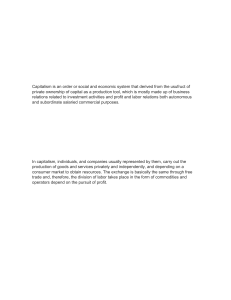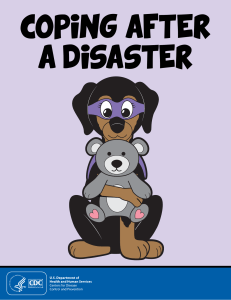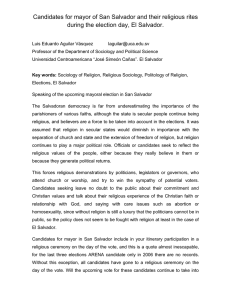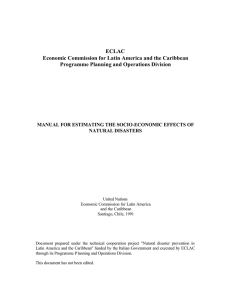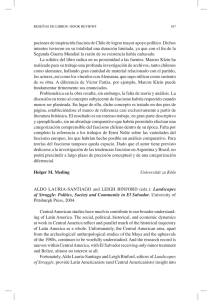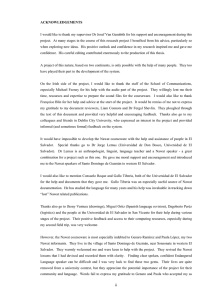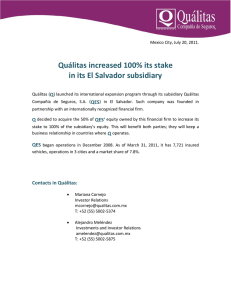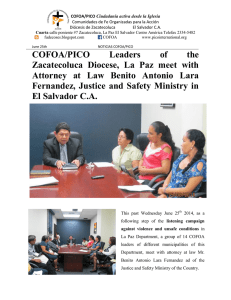WISNER 2001 Capitalism and the shifting spatial and social distribution of hazard and vulnerability lessons for Mumbai
Anuncio
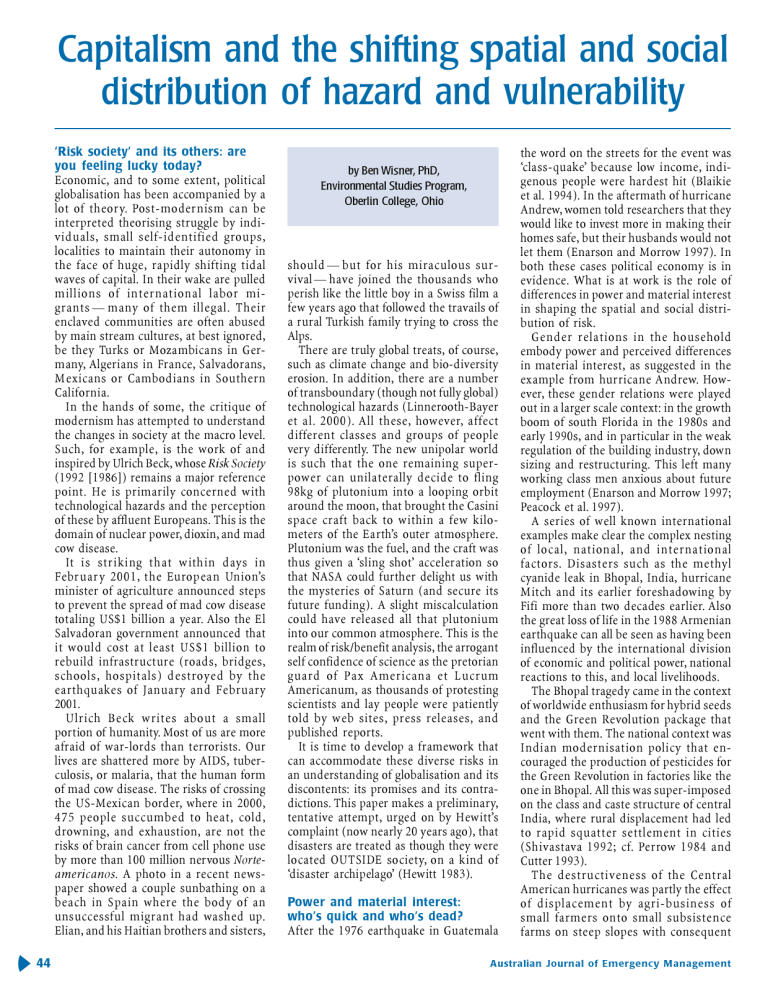
Capitalism and the shifting spatial and social distribution of hazard and vulnerability Risk society and its others: are you feeling lucky today? Economic, and to some extent, political globalisation has been accompanied by a lot of theory. Post-modernism can be interpreted theorising struggle by individuals, small self-identified groups, localities to maintain their autonomy in the face of huge, rapidly shifting tidal waves of capital. In their wake are pulled millions of international labor migrants many of them illegal. Their enclaved communities are often abused by main stream cultures, at best ignored, be they Turks or Mozambicans in Germany, Algerians in France, Salvadorans, Mexicans or Cambodians in Southern California. In the hands of some, the critique of modernism has attempted to understand the changes in society at the macro level. Such, for example, is the work of and inspired by Ulrich Beck, whose Risk Society (1992 [1986]) remains a major reference point. He is primarily concerned with technological hazards and the perception of these by affluent Europeans. This is the domain of nuclear power, dioxin, and mad cow disease. It is striking that within days in February 2001, the European Unions minister of agriculture announced steps to prevent the spread of mad cow disease totaling US$1 billion a year. Also the El Salvadoran government announced that it would cost at least US$1 billion to rebuild infrastructure (roads, bridges, schools, hospitals) destroyed by the earthquakes of January and February 2001. Ulrich Beck writes about a small portion of humanity. Most of us are more afraid of war-lords than terrorists. Our lives are shattered more by AIDS, tuberculosis, or malaria, that the human form of mad cow disease. The risks of crossing the US-Mexican border, where in 2000, 475 people succumbed to heat, cold, drowning, and exhaustion, are not the risks of brain cancer from cell phone use by more than 100 million nervous Norteamericanos. A photo in a recent newspaper showed a couple sunbathing on a beach in Spain where the body of an unsuccessful migrant had washed up. Elian, and his Haitian brothers and sisters, 44 by Ben Wisner, PhD, Environmental Studies Program, Oberlin College, Ohio should but for his miraculous survival have joined the thousands who perish like the little boy in a Swiss film a few years ago that followed the travails of a rural Turkish family trying to cross the Alps. There are truly global treats, of course, such as climate change and bio-diversity erosion. In addition, there are a number of transboundary (though not fully global) technological hazards (Linnerooth-Bayer et al. 2000). All these, however, affect different classes and groups of people very differently. The new unipolar world is such that the one remaining superpower can unilaterally decide to fling 98kg of plutonium into a looping orbit around the moon, that brought the Casini space craft back to within a few kilometers of the Earths outer atmosphere. Plutonium was the fuel, and the craft was thus given a sling shot acceleration so that NASA could further delight us with the mysteries of Saturn (and secure its future funding). A slight miscalculation could have released all that plutonium into our common atmosphere. This is the realm of risk/benefit analysis, the arrogant self confidence of science as the pretorian guard of Pax Americana et Lucrum Americanum, as thousands of protesting scientists and lay people were patiently told by web sites, press releases, and published reports. It is time to develop a framework that can accommodate these diverse risks in an understanding of globalisation and its discontents: its promises and its contradictions. This paper makes a preliminary, tentative attempt, urged on by Hewitts complaint (now nearly 20 years ago), that disasters are treated as though they were located OUTSIDE society, on a kind of disaster archipelago (Hewitt 1983). Power and material interest: whos quick and whos dead? After the 1976 earthquake in Guatemala the word on the streets for the event was class-quake because low income, indigenous people were hardest hit (Blaikie et al. 1994). In the aftermath of hurricane Andrew, women told researchers that they would like to invest more in making their homes safe, but their husbands would not let them (Enarson and Morrow 1997). In both these cases political economy is in evidence. What is at work is the role of differences in power and material interest in shaping the spatial and social distribution of risk. Gender relations in the household embody power and perceived differences in material interest, as suggested in the example from hurricane Andrew. However, these gender relations were played out in a larger scale context: in the growth boom of south Florida in the 1980s and early 1990s, and in particular in the weak regulation of the building industry, down sizing and restructuring. This left many working class men anxious about future employment (Enarson and Morrow 1997; Peacock et al. 1997). A series of well known international examples make clear the complex nesting of local, national, and international factors. Disasters such as the methyl cyanide leak in Bhopal, India, hurricane Mitch and its earlier foreshadowing by Fifi more than two decades earlier. Also the great loss of life in the 1988 Armenian earthquake can all be seen as having been influenced by the international division of economic and political power, national reactions to this, and local livelihoods. The Bhopal tragedy came in the context of worldwide enthusiasm for hybrid seeds and the Green Revolution package that went with them. The national context was Indian modernisation policy that encouraged the production of pesticides for the Green Revolution in factories like the one in Bhopal. All this was super-imposed on the class and caste structure of central India, where rural displacement had led to rapid squatter settlement in cities (Shivastava 1992; cf. Perrow 1984 and Cutter 1993). The destructiveness of the Central American hurricanes was partly the effect of displacement by agri-business of small farmers onto small subsistence farms on steep slopes with consequent Australian Journal of Emergency Management Winter 2001 A McColl deforestation. International markets for beef, bananas, cotton, and coffee drove this displacement, while historic patterns of inequality in land access and political power absorbed and translated these forces into unsafe conditions at the local level (Comfort et al. 1999; cf. Diaz and Pulwarty 1997). The standardised, modular, cheap apartment buildings that collapsed in Armenia were partly a result of Cold War competition that diverted resources in the Soviet Union into defence spending, as well as the centralist and technocratic nature of the Soviet state. Ineffective response to the emergency was also partly shaped by centralist control of communication as well as a cultural and linguistic mismatch between Russian-speaking officials and the Armenian-speaking population (Comfort 1999). In none of these cases would I argue that power and material interest fully determine a disastrous outcome. Many other factorssocial, technical, administrative, and legal, among others also contributed (Wisner 1993a; 1996; 1998). However, a full understanding of such disasters is impossible without taking the political economy into account. Recent earthquake tragedies in El Salvador and the Indian state of Gujarat also cry out for analysis on complex root causes. It is not part of the human condition to be buried under a landslide triggered by an earthquake. Earthquakes happen. But the disaster follows because of human action and inaction. In the case of the middle-income neighborhood of Las Colinas in Santa Tecla, just outside the capital, San Salvador, 400 homes were lost beneath a wall of debris from a collapsing slope above. This was not an act of God. A group of Las Colinas residents and environmental groups were in court in last year (2000) to stop development on that slope and the ridge above. The judge ruled against them. A former San Salvador planner, Clarisa Rodriguez, told The Economist magazine that restrictions against building in high-risk areas are sometimes not enforced. It is not an act of God that no more than 10% of the multi-storey structures in Indian cities are built according to earthquake resistant norms. The earthquake didnt kill, but the buildings did. And the buildings go up rapidly with little planning and inspection in a boom economy like Gujarats. In El Salvador and also in Gujarat, both the poor and the middle class suffered. In both places hungry rural people have been top: In El Salvador, many homes were lost beneath a wall of debris from a collapsing slope above. above: In Gujarat, the earthquake didnt kill, but the buildings did. (images courtesy International Federation of Red Cross and Red Crescent Societies) migrating in search of work to cities like San Salvador, Ahmedabad, and Bhuj. They become squatters who live in makeshift dwellings in some of the most potentially dangerous areas in an earthquake. They have little or nothing to invest in making their homes safer, and little incentive because they dont own the land where theyve built. In San Salvador and Ahmedabad alike, the middle class is attracted to the rapidly growing edge of the sprawling cities (Satterthwaite 1999). Developers and contractors rush to fill this market demand, often in too much haste to observe building codes. This is where the landslide buried hundreds in Las Colinas, and where new apartment houses for Ahmedabads salaried workers came crashing down. In El Salvador and India, rural impoverishment and crisis has led to large numbers of wage migrants crowding informal settlements in the major cities. Gujarats booming economy has attracted landless and land poor people from all over northern and central India. Ten thousand of these nameless laborers were killed a few years ago when a cyclone came out of the Arabian sea and hit flimsy shanties where they lived near the ship breaking and scrap metal industries.1 To summarise: economic and political powerand their interactionsare critical for understanding and preventing future disasters. What good is political economy? Having worked for some years in projects that have exposed me to the daily routine of planners and risk managers2,I hear a question. Why should political economy interest the natural hazard and disaster management community? There are two levels of answer. I will first deal with that routine practice as I have seen it in various parts of the world. Later I will Notes 1. Details and references to events in Gujarat and El Salvador are available on RADIX, a web site dedicated to radical interpretations of disasters and radical solutions: www.anglia.ac.uk/geography/radix 2. Earthquakes and Megacities Initiative (EMI): www.megacities.physik.uni-karlsruhe.de/ 45 speak more generally about why an understanding of economic and political power is essential for people, for Aristotles political animals, and not just managers. A first important reason is that implementation of ideas about mitigation and prevention has to take place in existing economic and political circumstances. Both national and local initiatives succeed or fail to the extent that they are compatible with existing patterns of power and material interest. Consider as an example a refinery complex recently acquired in a merger by a large holding company. This company has borrowed heavily to pay for the merger. They want to cut costs. These same executives want the restructured refinery to appear more efficient so that its stock value increases and their personal wealth in executive stock options grows. Employee downsizing is the key to cost reduction and the short-term appearance of efficiency. The refinery in-house fire brigade is eliminated. Fire fighting is now the responsibility of the local-city and county. Maintenance is also cut back. Small fires are more frequent and there is the danger that they will not be contained quickly. Low income immigrant residents adjacent and down wind of the refinery are concerned but have less political voice than the absentee owners of the holding company, who make large campaign contributions to politicians.3 Nothing described above is illegal, at least not in the United States. Politicians, holding company executives, refinery managers share a common belief in growth, efficiency, and de-regulation key concepts of neo-liberal ideology. In order to mitigate risks in this situation, either a win-win solution has to be sought within the limits of the refinerys newly defined bottom line, or the nexus of power and material interests has to be questioned, and with it the ideology that limitless growth, narrow definition of efficiency, and minimum regulation are good. This is where one has to begin to use the C word. One has to ask how capitalism, as a manner of organising power and material interest, has changed over past hundred years or so. What are the characteristics of capitalism today that contribute to an uneven spatial and social distribution of risk? Neoliberalism: on the dangers of the greed In the early part of last century capitalism was characterised by a more positive 46 relationship between production and improved quality of life. Since roughly the period when Henry Ford invented his factory system several changes have eroded the fit between capitalisms functioning and quality of life. I want to argue that these same changes in the nature of contemporary capitalism make it more difficult to come up with winwin approaches to hazard mitigation and the use of market mechanisms to provide incentives for self-protection by the working class. Here are some of the principle characteristics of what Pope John Paul has called savage capitalism, what others term global, foot loose, post-Fordist, wild, rampant, triumphant, and predatory (Korten 1995; Mander and Goldsmith 1996; Corbridge et al. 1994; Harvey 1982 & 2000) and what the UN Institute for Social Development Research has called,globalisation with a human mask (UNRISD 2000). First, many workers today are not able to consume the goods and services they help to produce for export or for their own countrys upper middle class and elite. At the extreme, there are many rural people in the world who produce food and fiber for the world market, but are unable adequately to feed themselves. The young women making Nike shoes in Vietnam will never save enough to own such footwear themselves. In the US and parts of Europe, global competition, industrial downsizing, out-sourcing, the rise of the service economy and deunionisation have combined to increase the number of temporary, part-time, and minimum wage workers (Chossudovsky 1997; Sassen 1998). Second, the link between capitalist production and general well being has been severed by the growth of military and luxury production. The percentage of capitalist production devoted to such waste has increased since Henry Fords day, accelerating during the Reagan/ Thatcher/Kohl cold war end game. Workers cant get to work in Trident submarines or B-1 bombers, and fur coats dont trickle down (OConnor 1994; Daly and Cobb 1989). Third, contemporary capitalism is committed to maximising growth irrespective of negative long term environmental consequences. The U.S. still has not ratified the Kyoto accord on green house emissions. In fact, it scuttled global warming negotiations recently in the Hague and Oslo. In the United States and much of Europe development continues to eat away at peri-urban land. Growth without regulation seems to have become a core value (Daly and Cobb 1989; Jaeger 1994; Sachs 1999; OConnor 1994; Durning 1992). One insightful study of this process in El Salvador juxtaposes sterile growth with development, meaning human or social development (Rubio, Arriola, and Aguilar 1997). The consequences for hazard mitigation of these trends are numerous. First, overseas, where predatory foreign and national capital rapidly deplete forest cover, drill for oil, delve for minerals, set up sweat shops and plantations for cheap exports, the workers and rural people are faced with vast environmental destruction, insecure, low wage jobs, hazardous working and living conditions. It is the rare Third World state that has been able to contain the negative effects of such growth despite great social unrest. An indirect, but important, consequence for the U.S. is that a large proportion of aid money that could have gone for sustainable development overseas is absorbed by disaster foreign assistance (Bales 1999; Reed 1996; Johnston 1997, UNRISD 1995 & 2000). Second, in the U.S., growing polarisation between the rich and poor (including many immigrant workers) means that community based approaches to mitigation will find it more difficult to get representation and volunteer activity from the least affluent and marginalised end of the income distribution. Even the middle class is working harder according to Harvard economist Juliet Schor, and charities have noted a decline in volunteerism across the board (Schor 1996; Mander and Goldsmith 1996). This polarisation also manifests itself in a growing urban-rural gap in income, infrastructure, access to information, and security. In the U.S., Australia and much of Europe agribusiness corporations are squeezing out multiple generation family farmers because of the formers scale, access to capital intensive technology, and vertical integration. As rural population declines, rail trunk lines are being eliminated. Rural exodus is fed by a vicious cycle that includes eroding access to health care by an aging family farm population, closure of schools and public libraries, and public transportation. In the U.S. refugees from farm foreclosures end up living in mobile homes near low wage manufacturing jobs in the ununionised Notes 3. Example is a composite of situations encountered in the course of field work during the United Nations University project on Urban Social Vulnerability, greater Los Angeles 1998-2000; cf. Wisner (1999). Australian Journal of Emergency Management South. Mobile homes are notoriously unsafe because of the location of trailer parks in flood plains in the United States and because of their instability in high winds (Steinberg 2000, pp. 90-96 & 106-8). As a result of the growth of agribusiness in some regions and globalised non unionised manufacturing in other rural regions, very complex new problems emerge from an industrial ecological point of view. In terms of acute, sudden chemical accidents, one study of nearly 2,000 accidents reported to United States Environmental Protection Agency from 1994-99 shows that about 12% occurred in farm supplies wholesalers, poultry processing, refrigerated warehousing and storage facilities, and animal slaughtering (Kleindorger, Feldman, and Lowe 2000: Table 6 http://opim.wharton.upenn.edu/ risk/epi_download.html). Third, the economically marginalised are unlikely to be able to respond to incentives (e.g. lower insurance rates, subsidies) for retrofitting their residences (Mileti 1999). Fourth, much of the growth taking place world wide and in the U.S. in particular is perverse. That is, it is growth that does not increase general welfare in the long run. Addition of the n-th, incremental shopping mall, multiplex cinema, golf resort, office park creates profits for a few, distraction for some, stress for many, and planning nightmares for those concerned with transportation, evacuation, other infrastructure, service provision and open space. Much critical infrastructure is already under-maintained due to cut backs in public finance at many levels. Sprawl adds new infrastructure in need of future maintenance, without which it may collapse or malfunction in an extreme event (Durning 1992; Abramovitz 2001; Burby 1998; Godschalk 1999; Mitchell 1999; Ayres and Weaver 1998; Inoguchi et al. 1999; Weizsaecker et al. 1997). One of the most important ways economic globalisation is redistributing risk is via international and internal migration. For example, in the Pico Union district of the City of Los Angeles there are several thousand indigenous Maya from Guatemala, many of whom do not speak Spanish, let alone English. They are fugitives of the genocide against rural people during the worst of Guatemalas civil war in the 1980s. They live in crowded and poorly maintained tenements and work in sweatshops that manufacture clothing. Most are undocumented immigrants. They are an invisible and relatively powerless group of human beings caught in the gears of a complex Winter 2001 mechanism that links U.S. historical support for Central American oligarcharies and their military forces with neoliberal regimes of accumulation. These people are highly socially vulnerable to a variety of health hazards and also earthquake and building fire4. Gujarat provides an example of how internal migration affects the social and spatial distribution of risk, and how economic development creates such migration flows5.This Indian state is an economic power house. As such, one sees there in microcosm the enormous gap between rich and poor that characterises India itself, and the world. Much of this economic growth is linked to global markets. Its successful economy has come at the cost of having to accommodate somewhere a very large population of unskilled labor. These people have migrated there from all over northern India because their lives as landless laborers elsewhere were untenable. Gujarat is to be the major beneficiary of the water diverted by all the dams on the controversial Narmada river system (see Arundhati Roys passionate little book, The Cost of Living 1999)6. It needs this water for irrigation in an attempt to anchor the livelihoods of some desperately poor rural people in its hinterland who have not benefited from the states economic growth. If it doesnt do something like this, they, too, will move to the cities whose names we are reading in news accounts of the earthquake (Bhuj, Ahmedabad). My guess is that already over the past few years these towns have been sprouting hutments, encroachments, and squatter settlements for this precise reason. But rural crisis and exodus has long been the by-product of modernisation and growth in India. The original green revolution of the mid 1960s introduced hybrid seeds and packages of practices and inputs for their use that pushed small farmers off the land, which was then accumulated by larger farmers. Farm production grew impressively, but the winners were urban people with purchasing power, not the dislocated rural poor (Shiva 1989; Dreze 1990). Another push from the countryside into these townsthis perhaps more speculative, but based on inference from other border situationsis that Indian army defensive operations near the border with Pakistan may have disrupted already fragile livelihoods. Finally, one must consider the cultural as well as economic and political situation of the tribal (adavasi) people in India generally and in Gujarat in particular. Many of the people who may have been losers and not winners in the growth stimulated by globalisation, especially in the isolated northern parts of Gujarat, where the shaking was most extreme, are ethnic minorities. They have received very few government services over the years, tend to be displaced by so-called development projects, and often end up among the poorest of urban squatters when they are displaced. Nasty, brutish and short: is there an alternative? What alternatives are there? First, as I suggested earlier when imaging the objections of managers I respect, one can try to work within the existing capitalist order, showing corporations where their interests overlap with those of the general public. One can also try to work with marginal economic groups using innovative tools such as micro-credit for home and community safety improvements. This is similar to the approach of FEMAs Project Impact, the Inter-American Development Bank, and some NGOs in Latin America and India, as well as the approach in much of Europe, Australia and New Zealand, and the urban-industrial enclaves of Asia and the Pacific (IAB 2000). It is the approach that underlies the creation at the end of the International Decade for Natural Disaster Reduction (IDNDR) of the ProVention Consortium by the World Bank 7. ProVentions concerns range from novel and innovative catastrophe bonds to assist the worldwide reinsurance industry to the use of micro credit among the poor as a way of financing investments in home safety. Successes can be achieved and some improvements in public safety can result (World Bank 2001). However, in the long run a second, complementary, initiative is necessary. Full hazard mitigation, as a mainstream part of sustainable development, is impossible without challenging the prevailing ideals of limitless growth, of ever decreasing governmental regulation, and of the dominance of market values. The broad coalition of unions, environmental groups, consumer advocates, Notes 4. Field observations, United Nations University project on Urban Social Vulnerability, December 2000. 5. See details and select bibliography on RADIX: www.anglia.ac.uk/geography/radix 6. Also see the report of The World Commission on Dams: www.dams.org/ 47 churches, and other citizen based organisations present in Seattle, Washington, and Prague to protest the World Trade Organisation show that such questions are being asked widely. Citizen and worker education about the way that power, economics, land use, well being, and safety interact can provide a growing base for those on boards of directors and those in government that realise that sustainable growth is an oxymoron, and that sustainable development has to do with an increase in the quality of life for all of us. Thus, an important strategic move would be to link hazard mitigation efforts to the agendas of unions and citizen based groups concerned with electoral reform, corporate accountability, and environmental justice. A good start would be for such popular coalitions to push for a national dialogue on sustainable development as the context for recovery planning whenever a disaster occurs. Following hurricane Mitch a broad cross section of Nicaraguas citizens demanded such a dialogue. The then and present government resists such a broader democratic context for resource allocation, but such a struggle could eventually bring in an elected government more attuned to the popular will. In the post Mitch period, civil society in Nicaragua succeeded in articulating a new vision of sustainable development in that country8. For so-called recovery to be anything more than the reestablishment of the status quo ante that make people, schools, hospitals vulnerable in first place, there must be a broader development vision. Business as usual will only reproduce the pre-conditions for yet more disasters (Susman et al. 1983; Blaikie et al. 1994; Hewitt 1996). At this writing (February 2001), various sources9 have reported that not only has the very conservative ARENA government of President Flores rejected wide appeals from citizen groups for such a national dialogue, it is moving ahead very rapidly with nothing more than business as usual 10 . In El Salvador this means a neoliberal, dependent capitalism that has opened up the country to low wage sweatshops owned by foreigners. Public budgets that could have been used to strengthen schools and hospitals have been cut, and produced a pro business atmosphere in which developers of luxury homes could go to court and get building restrictions waived. This last was one of the precursors to the landslide in Santa Tecla, outside San Salvador, on 13 January, that buried 400 homes. 48 Furthermore, the government has forced the early retirement of seveneighths of its public works employees in order to clear the way to give contracts to private contractors to do the work of repair and reconstruction of damaged and destroyed infrastructure! Imagine the captain of a life boat ordering its occupants to throw their oars overboard because, on the horizon, he thinks he sees a powerful boat coming to tow them to safety! It is neither certain that this private sector tow-boat is capable of the task, nor even that it is sea-worthy. Nor is the direction in which it might tow the whole society certain. Privatisation can bring many surprises, as California has discovered to its cost as its energy utilities struggle with a $12 billion debt following electricity privatisation and as Great Britain has seen with the disastrous state of its privatised railways. Such, however, is the nature of capitalism in the era of globalisation. By contrast, according to a Citizens Declaration, published by a wide coalition of groups in El Salvador in mid February 2001, following the third destructive earthquake since January, radically different recovery priorities appear: housing and refugee camps, employment and reactivation of the productive apparatus, and environmental and social vulnerabilities11. The organisation responsible for coordinating the formulation of this Citizens Declaration is FUNDE (National Fund for Development/ Fundacion National para el Desarrollo)12. It is a non-profit organisation set up in El Salvador at the end of the civil war, in 1992, as a national forum for alternative thinking about human development and support of regional and local projects. It has a dense, decentralised, nation-wide network, and consults these localities as well as other networks (womens, health, etc.) when formulating the kind of declaration referred to above. FUNDE is also part of a worldwide network of 1,300 citizens groups that have joined together to question the direction of globalisation and its impact on their lives and communities13. This then brings us full circle, back to remarks at the beginning that one needs to look further than Becks Risk Society. Globalisation is making the game of life more risky for many as it provides an illusion of security for some. The social and spatial distribution of risks of all kinds are changing. We must make every effort to understand these changes and to work in solidarity with civil society to demand alternatives (Bernard et al. 1997; Pye-Smith et al. 1994; Varley 1994; Maskrey 1989). The reasons, to paraphrase two fine Western authors: No man is an island (John Donne), and It is not enough to understand the world, one must work to change it (Karl Marx). A human rights approach to disaster prevention? A necessary, but not sufficient, support for the demands by civil society for an alternative to the carnage in Gujarat, El Salvador in 2001, Turkey, Greece, and Taiwan in 1999, and back through the recent past, is recognition of protection from avoidable harm in extreme natural events as a human right. The foundations for such an approach have already been laid by the work of international organisations and human rights activist working on other questions (Johnston 1997; Boyce 2000; Kent, Aysan, Molin, and World Disasters Report 2000, chapter 8all on the RADIX web site14). In particular, U.N. agencies have provided three kinds of things so far. These are necessary, but they are not sufficient to initiate the sea change in how nations deal with natural hazards. These are: technical knowledge, support for institution building, and financial assistance through grants and loans. The missing ingredient is the kind of moral imperative that can mobilise local political will. It is when the world at large agrees to standards of responsibility by nation states toward their citizens in the form of treaties, covenants and other agreements, that this moral force is felt most strongly. Why, then not set our sights on an international treaty that commits governments around the world to apply low-cost solutions based on available knowledge to prevent such tragic, avoidable loss? Networks of scientists and engineers exist that could take on the technical work of defining these standards. These networks were created in part by the IDNDR10 years of scientific exchange Notes 7. www.proventionconsortium.org/ 8. CEER web site: www.ccer.ipeople-international.com. Also see Barraclough and Moss (1999). 9. Oxfam UK 15 February 2001, excepted from Reliefweb: www.reliefweb.int/; CISPES 14 February 2001, excerpted from www.cispes.org 10. See the bibliography in RADIX for background on the civil war in El Salvador and the role of this conservative political party: www.anglia.ac.uk/ geography/radix. 11. www.funde.org/declaracion.htm 12. www.elobservatorio.org/globalizacion.htm 13. SAPRIN, www.saprin.net/saprin.htm Australian Journal of Emergency Management mandated by the United Nations. However, this International Decade left unfinished business. Science was exchanged, but generally it hasnt been applied. Such an effort would require thousands of experts to work out the low-cost, minimum practices required to avoid further such tragedies. These scientists and engineers would have to sit down with lawyers, legislators and policy experts to work out how the minimum standards would be enforced. This is not an impossible task. It has happened before. One recent example is the exchange among hundreds of agencies that work in humanitarian and disaster relief that led to agreement on a very detailed set of minimum technical standards for relief. Known as the SPHERE project15, its published document covers food, water, shelter, health care, and many other aspects of relief. There are also many internationally agreed safety standards for the chemical industry, airline industry, nuclear power industry, etc. It has happened already where global warming is concerned. The Inter-governmental Panel on Climate Change (IPCC) 16 has mobilised thousands of scientists, and their work has gone into the treaty-making process that led to the Kyoto Accord on greenhouse gas emissions. Could the U.N. not create a parallel Inter-governmental Panel on Natural Disaster, that would, in a similar way, act to mobilise existing knowledge and feed it into a treaty making process? Such a body is necessary because so many different kinds of knowledge and expertise is required. No single existing specialised agency of the U.N. such as UNESCO, UNEP, WHO, or WMO covers all the specialist knowledge that would be required. That is one of the reasons that the IPCC was created. Preparing for the impacts of global warming requires many kinds of knowledge from areas such as public health, economics, agriculture, oceanography, in addition to expert understanding of world and regional climates. What would be done during the many years that such a treaty would be in the making? The beauty of this process is that the low-cost solutions will filter out into society. Citizens groups will demand action by their governments, as they did Notes 14. www.anglia.ac.uk/geography/radix 15. www.styluspub.com/books/book4641.html 16. www.ipcc.ch/ . See also Ian Burtons comment on RADIX: www.anglia.ac.uk/geography/radix Winter 2001 in Turkey when it became clear that contractors hadnt followed building codes and had used low quality materials. Or in South Florida, in the USA, when it came to light that poor construction methods were responsible for much avoidable damage in hurricane Andrew. Prevention of disasters has to come from the bottom up as well as from the top down (Harvey 2000; Platt 1999; FEMA 1997; Alexander 2000; Kirby et al. 1995; Wisner 1995; 1993a & 1993b). Absolute safety is not a human right. Safety from avoidable loss, injury and death is. Nothing in the Universal Declaration of Human Rights makes much sense if the human beings who are supposed to enjoy these rights can be snuffed out because a government neglected to enforce its own building codes. More information on a rights-driven approach to disaster prevention is available at: www/anglia.ac.uk/geography/ radix. Further reading...on contemporary capitalism Introductory Durning A. 1992, How Much is Enough? The Consumer Society and the Future of the Earth, W. Norton, New York. Korten D. 1995, When Corporations Rule the World, Kumarian Press, West Hartford. Mander J. and Goldsmith E., (eds.) 1996, The Case Against the Global Economy and For a Turn Towards the Local, Sierra Club Books, San Francisco. More detailed Bales K. 1999, Disposable People: New Slavery in the Global Economy, University of California Press, Berkeley. Chossudovsky M. 1997, The Globalization of Poverty, Zed Books, London. Corbridge S., Martin R., Trift N., (eds.) 1994, Money, Power and Space, Blackwell, Oxford. Harvey D. 1982, The Limits to Capital, University of Chicago Press, Chicago. Johnston B., (ed. 1997, Life and Death Matters: Human Rights and the Environment at the End of the Millennium, Altamira Press, Walnut Creek, CA. OConnor M., (ed.) 1994, Is Capitalism Sustainable? Guilford, New York. Reed D., (ed.) 1996, Structural Adjustment, the Environment and Sustainable Development, Earthscan, London. Rubio R., Arriola F.J. and Aguilar J.V. 1997, Crecimiento Esteril o Desarrollo, FUNDE, San Salvador. Sassen S. 1998, Globalization and its Discontents, The New Press, New York. Schor J. 1996, The Overworked American, Harvard University Press, Cambridge. United Nations Research Institute for Social Development (UNRISD) 1995, States of Disarray: The Social Effects of Globalization, UNRISD, Geneva. UNRISD 2000, Visible Hands: Taking Responsibility for Social Development, UNRISD, Geneva. On sustainable development Introductory Bernard T. and Young Y. 1997, The Ecology of Hope: Communities Collaborate for Sustainability, New Society Publishers, Gabriola Island, BC, Canada. Daly H. and Cobb J. 1989, For the Common Good: Redirecting the Economy toward Community, the Environment, and a Sustainable Future, Beacon, Boston. Satterthwaite D., (ed.) 1999, The Earthscan Reader in Sustainable Cities, Earthscan, London. More detailed Ayres R. and Weaver P., (eds.) 1998, EcoRestructuring: Implications for Sustainable Development, United Nations University Press, Tokyo. Barraclough S. and Moss D. 1999, Toward Greater Food Security in Central America Following Hurricane Mitch: Rethinking Sustainable Development Priorities, Oxfam America, Boston. Harvey D. 2000, Spaces of Hope, University of California Press, Berkeley. Inoguchi T., Newman E., Paoletto G., (eds.) 1999, Cities and the Environment: New Approaches for Eco-Societies, United Nations University Press, Tokyo. Jaeger C. 1994, Taming the Dragon: Transforming Economic Institutions in the Face of Global Change, Gordon and Breach Science Publishers, Yverdon, Switzerland. Kirby J., OKeefe P., Timberlake L., (eds.) 1995, The Earthscan Reader in Sustainable Development, Earthscan Publications, London. Kleindorfer P.R., Feldman H., and Lowe R.A., Accident Epidemiology and the U.S. Chemical Industry: Preliminary Results from RMP* Info, Working Paper 00-01-15, Center for Risk Management and Decision Processes, The Wharton School, University of Pennsylvania, March 6 2000, http:// opim.wharton.upenn.edu/risk/epi_ downloads.html]. Pye-Smith C., Feyerabend G., Sandbrook R. 1994, The Wealth of Communities, Kumarian Press, West Hartford. Roy A. 1999, The Cost of Living, Flamingo, London. Sachs W. 1999, Planet Dialectics, Zed Books, London. Shiva V. 1989, Staying Alive: Women, 49 Ecology and Development, Zed, London. Weizsaecker E., Lovins A. and Lovins H. 1997, Factor Four: Doubling Wealth Halving Resource Use, Earthscan, London. On risk, vulnerability, and mitigation Introductory Abramovitz J. 2001, Averting Unnatural Disasters, in Brown L., Flavin C. and French H., (eds.), State of the World 2001, New W. W. Norton, York, pp. 123142. Blaikie P., Cannon T., Davis I., Wisner B. 1994, At Risk: Natural Hazards, Peoples Vulnerability, and Disasters, Routledge, London. Boyce J. K. 2000, Let Them Eat Risk? Wealth, Rights and Disaster Vulnerability, Disasters Vol. 24, No. 3, pp. 254261. Cutter S. 1993, Living with Risk: The Geography of Technological Hazards, Eduard Arnold, London. Hewitt K. 1996, Regions of Risk, Longman, London. Maskrey A. 1989, Disaster Mitigation: A Community Based Approach, Oxfam, Oxford. Steinberg T. 2000, Acts of God: The Unnatural History of Natural Disaster in America, Oxford University Press, New York. Varley A. (ed.) 1994, Disasters, Development and Environment, Wiley, Chichester. More detailed Alexander D. 2000, Confronting Catastrophe: New Perspectives on Natural Disasters, Oxford University Press, New York. Beck U. 1992, Risk Society: Towards a New Modernity, Sage, London. [Translation of Risikogesellschaft: Auf dem Weg in eine andere Moderne, Suhrkamp, Frankfurt am Main, 1986]. Burby R. (ed.) 1998, Cooperating with Nature: Confronting Natural Hazards with Land-Use Planning for Sustainable Communities. Washington, Joseph Henry Press, D.C. Comfort L. et al. 1999, Reframing Disaster Policy: The Global Evolution of Vulnerable Communities, Environmental Hazards Vol. 1, pp. 3944. Comfort L. 1999, Shared Risk: Complex Systems in Seismic Response, Pergamon, Amsterdam. Diaz H. and Pulwarty R. (eds.) 1997, Hurricanes: Climate and Socio-Economic Impacts, Springer Verlag, Berlin. Dreze J. 1990, Famine Prevention in India, in Dreze J. and Sen A. (eds.) The Political Economy of Hunger, Vol. 2, pp. 13 122, Clarendon, Oxford. Enarson E. and Morrow B. (eds.) 1998, 50 The Gendered Terrain of Disaster: Through Womens Eyes, Praeger, Westport. Hewitt K. (ed.) 1983, Interpretations of Calamity, Allen Unwin, Boston. Inter-American Development Bank (IDB) 2000, Facing the Challenge of Natural Disasters in Latin America and the Caribbean: an IDB Action Plan, : InterAmerican Development Bank, Washington, D.C., www/iadb.org/sds/env. Federal Emergency Management Agency (FEMA) 1997, Multi-Hazard Identification and Risk Assessment, FEMA, Washington, D.C. Godschalk D. et al. 1999, Natural Hazard Mitigation: Recasting Disaster Policy and Planning, Island Press, Washington, D.C. Linnerooth-Bayer J., Loestedt R. and Sjoestedt G. 2000, Transboundary Risk Management, Earthscan, London. Mileti D. 1999, Disasters by Design: A Reassessment of Natural Hazards in the United States, Joseph Henry Press, Washington, D.C. Mitchell J. (ed.) 1999, Crucibles of Hazards: Mega-Cities and Disasters in Transition, United Nations University Press, Tokyo. Peacock W., Morrow B., Gladwin H. (eds.) 1997, Hurricane Andrew and the Reshaping of Miami, Routledge, London. Perrow C. 1984, Normal Accidents: Living with High-Risk Technologies, Basic Books, New York. Platt R. et al. 1999, Disasters and Democracy: The Politics of Extreme Natural Events, Island Press, Washington, D.C. Shrivastava P. 1992, Bhopal: Anatomy of a Crisis, Paul Chapman Publishing, London. Susman P., Wisner B. and OKeefe P. 1983, Global Disasters: A Radical Perspective, in Hewitt K., (ed.), Interpretations of Calamity, pp. 26383, Allen and Unwin, Boston. Wisner B. 2001, Managing Disasters: What the United Nations is Doing, What it Can Do, United Nations Chronicle Vol 37, No. 4, pp. 69. Wisner B. 1999, There Are Worse Things than Earthquakes: Hazard Vulnerability and Mitigation Capacity in greater Los Angeles, in Mitchell K. (ed.), Crucibles of Hazard, pp. 375427, United Nations University Press, Tokyo. Wisner B. 1998, The Geography of Vulnerability: Why the Tokyo Homeless Dont Count in Earthquake Preparations. Applied Geography Vol. 18, No. 1, pp. 2534. Wisner B. 1996, The Geography of Vulnerability, in J. Uitto and J. Schneider (eds.), Preparing for the Big One in Tokyo: Urban Earthquake Risk Management, pp. 2033, United Nations University, Tokyo. Wisner B. 1995, Bridging Expert and Local Knowledge for Counter-Disaster Planning in Urban South Africa, GeoJournal, Vol. 37, No. 3, pp. 335348. Wisner B. 1993a,Disaster Vulnerability: Scale, Power, and Daily Life, Geojournal, Vol. 30, No. 2, pp. 127140. Wisner B. 1993b, Disaster Vulnerability: Geographical Scale and Existential Reality, in H.G. Bohle (ed.), Worlds of Pain and Hunger, pp. 1354, Freiburg Studies in Development Geography 5, Breitenbach Publishers, Saarbrücken and Fort Lauderdale. World Bank 2001, World Development Report 2000-2001, Chapters 8 & 9. Acknowledgment I would like to acknowledge the stimulating discussions with a number of friends who share with me a sense of outrage that established knowledge is not yet applied and enforced by governments, thus creating needless suffering, as in Gujarat and El Salvador in January and February 2001: Sonia Kruks, Maureen Fordham, George Kent, David Alexander, Elaine Enarson, Ian Burton, John Twigg, Mark Pelling, Ilan Kelman, John Handmer, Barbara Johnston, Jeannette Fernandez, Omar Cardona, Cinna Lomnitz, Mel Luna, Carlos Meijia, Sarah Bradshaw, Phillip Buckle, Rich Olson, Tony Gibbs, Ken Hewitt, Stuart Mustow, Allan Lavell, Steve Bender, Nicole Appel , Helena Molin, Terry Jeggle, Peter Walker, Alcira Kreimer, and Greg Berger. Thanks as well to the team revising At Risk with me: Piers Blaikie, Terry Cannon, Ian Davis, and Ken Westgate, and to my colleagues in the United Nations University work on urban social vulnerability: Sergio Puente, Virginia Garcia, Shigeo Takahashi, Jean Tayag, William Pick, Ravi Sinha, Juha Uitto, and Jerry Valesquez. My gratitude as well to Tim Radford, Doug Cosper, and Linda Feldman for helping me turn the pigs ear of academic prose into the silk purse of good journalism. I am responsible for whatever might be considered over the top, despite such good advice. Authors contact details Dr Ben Wisner Environmental Studies Program, Oberlin College 373 Edgemeer Place Oberlin OH 44074-1075, USA. Email: bwisner@igc.org This article has been refereed Australian Journal of Emergency Management

